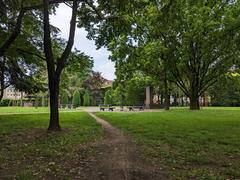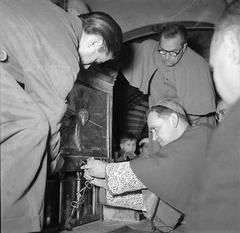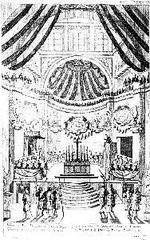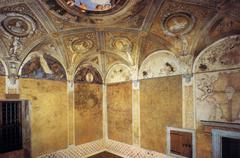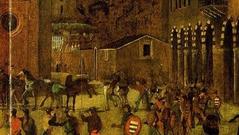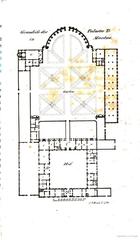Diocesan Palace Mantua: Visiting Hours, Tickets, and Historical Guide
Date: 14/06/2025
Introduction
Located in the heart of Mantua’s UNESCO-listed historic center on Piazza Sordello, the Diocesan Palace—also known as Palazzo Vescovile or Palazzo Bianchi—stands as a remarkable testament to the city’s religious, political, and architectural legacy. With origins tracing back to the medieval period, the palace has evolved under the stewardship of prominent local families and the church, serving as both a symbol of ecclesiastical authority and a repository of artistic treasures. Its proximity to the Cathedral of San Pietro and the Ducal Palace situates it at the nexus of Mantua’s religious and civic life, making it a compelling destination for art lovers, history enthusiasts, and travelers seeking a deeper understanding of Italy’s spiritual heritage (italyscapes.com; Strictly Italy; in-lombardia.it; Travel Connect Experience).
Though not open for daily public tours, the Diocesan Palace occasionally welcomes visitors for special guided tours and cultural events. Those interested should consult the Diocese of Mantua or local tourism offices for up-to-date information on visiting hours, ticketing, and accessibility. Exploring the palace alongside nearby architectural and religious landmarks offers a comprehensive perspective on Mantua’s layered history.
Table of Contents
- Origins and Early Ownership
- Transformations Through the Centuries
- 19th to 21st Century: Ecclesiastical Stewardship and Preservation
- Architectural and Artistic Highlights
- Practical Visitor Information
- Nearby Attractions
- Frequently Asked Questions (FAQ)
- Conclusion
Origins and Early Ownership
The Diocesan Palace’s story begins in the early 14th century, when the Agnelli family’s property was transferred to Rinaldo Bonacolsi, a prominent figure in Mantua’s medieval aristocracy. As the seat of the Bonacolsi, the palace was woven into the fabric of the city’s governance and power dynamics (italyscapes.com). In the late 16th century, it passed into the hands of the Negri family and later the Porta family, serving as a private residence for Mantua’s elite.
Transformations Through the Centuries
16th–17th Century: Noble Residences and Upheaval
During the stewardship of the Negri and subsequently the Porta family, the palace functioned as an aristocratic residence. The turbulent 17th century brought devastation to Mantua, especially during the War of the Mantuan Succession in 1630, which led to the sack of the city and significant damage to the palace. Portions were demolished, and the building’s structure was compromised, reflecting the broader destruction experienced throughout Mantua at this time (italyscapes.com).
18th Century: Neoclassical Rebirth
The palace underwent substantial reconstruction in the mid-18th century under Count Guido Porta, who replaced two pre-existing structures with a grand, unified building. In 1756, the property was sold to Marquis Giuseppe Bianchi, whose name the palace still bears. Noteworthy enhancements included a magnificent staircase built in 1765 and vaulted ceilings frescoed by renowned Mantuan painter Giuseppe Bazzani. The neoclassical façade, adorned with the Bianchi coat of arms and classical statuary, reflects the artistic tastes of the Enlightenment (italyscapes.com).
19th to 21st Century: Ecclesiastical Stewardship and Preservation
In 1824, the palace transitioned from noble residence to the seat of the Diocese of Mantua, marking its enduring role as the bishop’s residence and curia headquarters. Further modifications, including the addition of an internal courtyard and attic, adapted the structure for ecclesiastical administration. In 1967, Bishop Antonio Poma established the diocesan historical archive within the palace, solidifying its function as a guardian of Mantua’s religious memory (italyscapes.com).
Today, the Diocesan Palace remains a focal point for Mantua’s ecclesiastical governance, cultural events, and heritage preservation, occupying a prominent position on Piazza Sordello alongside the Cathedral of San Pietro and the Ducal Palace (in-lombardia.it).
Architectural and Artistic Highlights
The Diocesan Palace’s architecture illustrates the stylistic evolution of Mantua. The neoclassical façade, symmetrical windows, and central Renaissance-style portal create an elegant exterior that harmonizes with Piazza Sordello’s historic cityscape (Strictly Italy). Inside, the palace features tranquil courtyards with arcaded walkways and classical columns, a grand staircase, and vaulted ceilings frescoed by Bazzani.
Frescoes, stucco decorations, and gilded details adorn the ceremonial halls, with themes ranging from religious allegories to local saints. The palace also houses an important collection of religious art, sacred vestments, and historical documents, some of which are displayed in the Diocesan Museum (Cattedrale Mantova). Notably, a Roman marble female head from the first century AD is exhibited in the museum, emphasizing the continuity of Mantua’s artistic tradition.
Practical Visitor Information
Visiting Hours & Tickets
- Opening Hours: The Diocesan Palace is typically open to visitors Tuesday through Sunday, from 10:00 AM to 5:00 PM. It is closed on Mondays and certain holidays. Hours may vary for special events; always consult the official website or tourist information.
- Tickets: Standard admission is around €8, with discounts for students, seniors, and groups. Combined tickets for the palace, cathedral, and museum are often available. Guided tours may incur an additional fee.
- Guided Tours: Multilingual tours can be booked in advance and are recommended for deeper insight into the palace’s history and art.
Accessibility
The Diocesan Palace offers partial accessibility, with ramps and elevators installed where possible, but some historic sections may present challenges. Visitors with mobility concerns should contact the administration in advance to discuss accommodations.
Travel Tips
- Best Time to Visit: Spring and autumn offer pleasant weather and fewer crowds. The palace is a highlight during Mantua’s Festivaletteratura in September (Bella Italia Goods).
- Photography: Non-flash photography is generally permitted except in restricted areas.
- Dress Code: Modest attire is required, especially when entering the cathedral or attending religious events.
- Getting There: The palace is in central Mantua, easily accessible on foot. Parking is available on the outskirts of the old town, with shuttle buses running regularly (Places of Juma).
Nearby Attractions
- Ducal Palace: A vast Renaissance complex with art collections and historical exhibitions.
- Cathedral of San Pietro: Mantua’s main cathedral, adjoining the palace.
- Piazza Sordello: The city’s medieval civic and religious core.
- Basilica di Sant’Andrea: Renowned for its Renaissance architecture and art.
- Rotonda di San Lorenzo: Mantua’s oldest church, dating to the 11th century.
Frequently Asked Questions (FAQ)
Q: What are the Diocesan Palace’s visiting hours?
A: Generally Tuesday–Sunday, 10:00 AM to 5:00 PM. Always check for updates on the official website.
Q: How much do tickets cost?
A: Standard admission is approximately €8, with discounts available. Combined tickets may offer savings.
Q: Are guided tours available?
A: Yes, guided tours in multiple languages can be arranged and are recommended for a thorough experience.
Q: Is the Diocesan Palace wheelchair accessible?
A: The palace is partially accessible; some historic areas may not be fully accessible.
Q: Can I take photographs inside the palace?
A: Non-flash photography is generally allowed, though restrictions may apply in certain rooms.
Conclusion
The Diocesan Palace of Mantua embodies centuries of religious, artistic, and civic history. Its striking neoclassical architecture, frescoed interiors, and significant art collections make it an essential destination for those interested in Mantua’s spiritual and cultural heritage. While access is primarily through special events or guided tours, the palace’s central location makes it an ideal addition to any exploration of Mantua’s historic core.
To ensure the best experience, check current opening hours and ticket options, consider a guided tour, and combine your visit with the city’s other landmarks. For real-time updates, event information, and audio guides, download the Audiala app and follow local tourism channels.
Sources and Further Reading
- Italyscapes – Palazzo Bianchi
- Strictly Italy – Things to do in Mantua
- In Lombardia – Ducal Palace
- Travel Connect Experience – Best Things to Do in Mantua
- Justin Plus Lauren – Mantua Travel Guide
- Garda Outdoors – Palazzo Te in Mantua
- Cattedrale Mantova – Visit to the Cathedral
- Places of Juma – Mantua Travel Guide
- Bella Italia Goods – Mantua: A Journey Through History and Culture
- The Euro Road Trip – Sights in Mantua
- Milano.zone – Mantua Comprehensive Travel Guide 2025
For more information, visit the Official Diocese of Mantua website and the Mantua Tourism Office.

